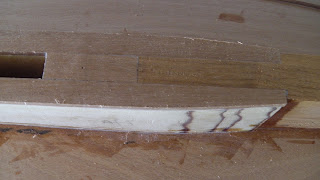Since the last post I have been sailing for a couple of days. I took my Navigator (see link on left) to a Wooden Boat Association messabout at Caloundra - 2 glorious days of sunshine and wind!
More to the point here, I finished the outer parts of the keel. The doublers on either side of the centreboard case were glued in place. The capping strips to cover the edge of the ply were shaped and fitted into housings routed out of the outer keel and skeg. When the glued had set the bottom of the keel, from stem to transom, was cleaned up with hand planes. As I expected, this was hard work because it involved reaching out over the first 2 planks.
The 3rd pair of planks were test fitted, trimmed where needed and glued in place, one yesterday and the other today.
The bilge runners fit on the edge of the 3rd plank and have to be laminated in place to suit the curve of the hull. I worked out where to put them, covered the hull with plastic so they don't stick to it, glued them up (4 pieces 42 x 12 mm) and clamped them in place. Here is a photo:
After the glue has set I will remove the bilge runner, clean the glue off and taper the ends before gluing and screwing it permanently to the hull.
Behind the bilge runner is the cleaned up keel. Click on the photo to enlarge it and you can see the ply doublers along the centreboard case and the capping strips.
Roger, who is about to start on building and Able, asked how I had faired the centreboard case into the forward keel and skeg. Here are a couple of photos show this transition, first from above and second from the side.
The view from above. The ply doublers on the sides of the centreboard case extend over the skeg by about 150mm and are covered by a hardwood strip that is let into a rebate cut in the skeg. The end of the case log is covered by a short piece of the same hardwood. the doublers and the cover strip are tapered off to a blunt end that I will fill with an epoxy fillet.
Here is a closeup view from the side.
I'm building a boat to a design by Paul Fisher of Selway Fisher Design in the UK. The design is called "Able" and her vital statistics are: overall length 4.88m (16ft), beam 2m (6ft 6in) and design weight is 360kg (790lbs). You can read more about this design at http://www.selway-fisher.com/OtherDB.htm#KANE.
I intend to procede more slowly with this boat than I did with either of my other boat building projects (see links below on the right). This is, after all, a hobby and there are other things to do. So, updates to this blog might happen once every week or two. Come back and see.
If you would like to contact me please Click to Send me Email
I intend to procede more slowly with this boat than I did with either of my other boat building projects (see links below on the right). This is, after all, a hobby and there are other things to do. So, updates to this blog might happen once every week or two. Come back and see.
If you would like to contact me please Click to Send me Email



No comments:
Post a Comment